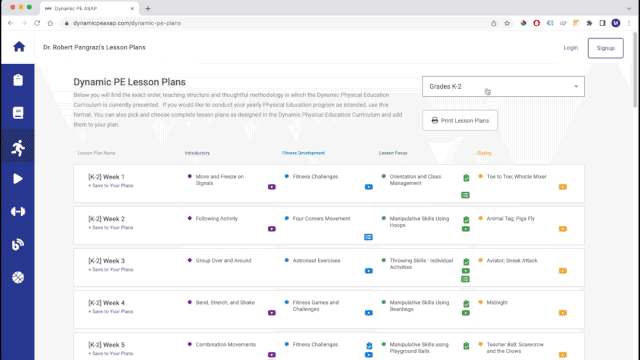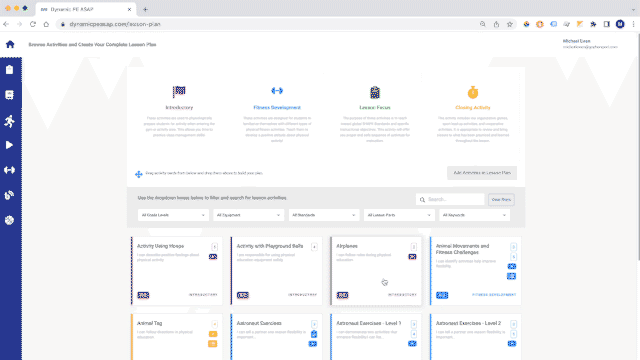If you are one of the many users who have logged into the website, Dynamic PE ASAP website, you may have noticed changes and additions. The biggest addition is that Grades 7-12 units and lesson plans were added and given equal billing to the elementary program. In fact, there are 29 units of instruction and over 250 lesson plans for secondary teachers. The purpose of this blog is to discuss the construction of a curriculum for your school or district. It is common practice for teachers to search for fitness routines, skills, and games. They have a basketful of things to teach, but they are not organized in any educational scheme. Instead, it becomes a “what should I teach today?” with little concern given to reaching standards and outcomes. A collection of games, fitness, and skill activities is not a curriculum.
A curriculum is a roadmap that delineates what you are planning to teach students and what they are expected to learn. It includes learning standards and outcomes your school district expects students to accomplish. Once there is agreement on standards and outcomes, a yearly outline and written lesson plans helps assure all students can reach specified outcomes. If it sounds like a big job, it is. The purpose of this blog is to show how DPE ASAP can expedite and streamline the curriculum development process.
Steps to Developing a Curriculum
1. Define a Guiding Philosophy
In most cases, the guiding philosophy will be written by a curriculum committee that guides the entire district. Most philosophies will include personal physical activity habits, developing and enhancing movement competency and motor skills, and a cognitive understanding of movement principles.
2. Consider all the Community Factors
There are many factors that will enhance or limit the scope of your curriculum. In short, they include school leaders, the community, the climate, the facilities and equipment you have access to, laws and requirements, your budget, and scheduling. All these factors will influence how you shape your curriculum
3. Define the Framework for the Curriculum
What is it you want to accomplish in terms of learning outcomes? As a teacher, you need to know what your community, school board, and administration expect students to learn. Undoubtedly, they want students to graduate from school knowing how to stay active and healthy. However, there are many paths to that end. For example, there might be an emphasis on athletic skills or the enjoyment of physical activity. A curriculum could place emphasis on the knowledge required for effective movement and daily activity. In most cases, the framework will be strongly influenced by the guiding philosophy.
4. Define the Framework for the Yearly Curriculum

There is no one curriculum that fits all schools and satisfies all teachers. Depending on the needs of students, the desires of parents, the focus of school administrators, and your personal competency, curriculums will differ. Click the link to view a starting point for designing your curriculum. Dynamic PE ASAP contains suggested yearly curriculum plans for each of three developmental levels: PreK-2, 3-4, and 5-8. There are 36 weeks of lesson plans for each developmental level curriculum. Review the suggested curriculum and note that scope, sequence, and balance have been considered at each level. Add new units, reorder existing units and activities, and make any other modifications to make it your curriculum.
5. Write Weekly Lesson Plans
Click the link to view a throwing lesson for grades PK-2. If you review the lesson, you will see it includes what equipment is required, what standards will be met, and what specific outcomes students should achieve. If you click on the view details box, all the activities to be taught are listed in proper progression.

The icons in the upper right corner signal there is a video showing how to organize and teach the unit, instructional signs for your throwing unit, and a formative assessment instrument included in the lesson.

If you prefer to not use the DPE curriculum as is, the drag-and-drop lesson builder is the tool to use. To see how to build your own lessons, click on this link. Using the lesson builder, use the search engine to search the database by grade level, equipment, standards, lesson parts, and keywords. This is an important tool when developing a curriculum for your district because it facilitates building a lesson that meets expected standards and outcomes. As you begin to build your curriculum you can easily find, select, and print what introductory activity, fitness routine, lesson focus, and game you are going to teach. Once you select your lesson parts, equipment, instructional signs, teaching videos, assessments, and outcomes and standards are included in your lesson.




